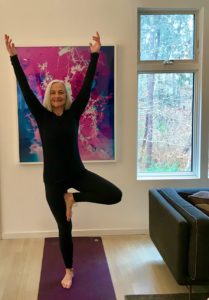We tend to think of the skeleton as an inert frame, but it is actually dynamic, living tissue. Bone cells are constantly breaking down the old and building up the new in a process called bone remodeling. But when the breakdown exceeds the build-up, bones get weaker. If the imbalance is severe, it’s called osteoporosis, which affects 54 million people in the U.S. One in two women and one in five men over age 50 will break a bone as the result of decreased bone health, according to the National Osteoporosis Foundation. The spine, hips, and wrists are most prone to fractures.
Exercise is part of the treatment. That’s because bones adapt to the demands placed on them. When you lift something, or hold yourself upright, your muscles pull on their bony attachments. Higher levels of this activity cause more production of new bone cells, which results in a stronger structure; less activity leads to slower production and a weaker structure.
Two types of movement can increase bone strength. The first is weight-bearing activity — including walking. The second is strength training.
Yoga crosses into both terrains. And it is not just for the young and flexible. People of all ages and abilities can benefit from yoga. An experienced teacher can help modify traditional poses to make the practice accessible for your body.
Here are three yoga-inspired exercises that I especially like because they strengthen bones and address balance, reducing the risk of falls and fractures. Give each one three to five breaths at first — then you can progress to practicing each for 10 to 15 breaths.
-

Strength and balance steady Donna Robertson as she reaches skyward in a tree pose. (Photo Kathy Stetson) The Tree: Strengthens legs and hips, improves balance. Stand tall, with your back against a wall, and lift your abdomen up. Place the sole of your left foot on the inside of the right calf or thigh (not on the knee joint). Now push the left foot and the right leg against each other. Extend your arms up and lengthen your body, like a tree growing toward the sun. Repeat, standing on the left leg. Progress by moving away from the wall.
- The Chair: Strengthens the front of the thighs and the spine. Stand with feet hip-width apart and parallel, with your back several inches from a wall. Bend your knees and reach your hips back until they touch the wall as you raise your arms overhead. Put your weight on your heels. Press your knees apart, kneecaps aligned over your feet. Lift the lower belly up to support your back. Progress to doing this without the wall.
- Modified Downward-Facing Dog: Increases strength in the arms, wrists, and spine; promotes strength and flexibility in the backs of the legs. Stand facing a wall, about 12 to 18 inches away from it, feet hip-width apart. Place your hands on the wall, above shoulder level, fingers pointing straight up. Straighten your arms and bend forward from your hips without rounding your back. Reach your hips back as your torso relaxes toward the floor. There should be one diagonal line, stretching from your hands to your hips. If your legs are tight, soften your knees. Progress by placing the hands on a chair or the floor.
A few things to keep in mind as you begin: Don’t do poses that involve forward bending of the spine, where your back becomes rounded, like the letter “C,” as these put stress on the vertebrae. Do try to maintain good spinal alignment. As you lengthen and extend your body, you stimulate the muscles that attach to the spine. And, as always, start gently and progress gradually.



